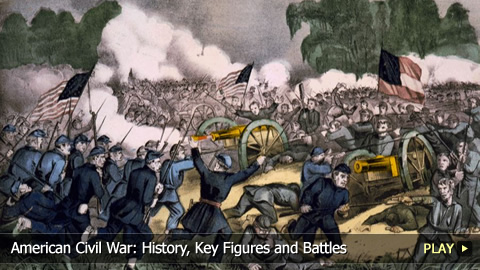American Civil War: History, Key Figures and Battles

advertisement
VOICE OVER: Rebecca Brayton
Though fighting in the American Civil War began April 12th, 1861, the events leading up to this outbreak of violence started years earlier. A rift between Northern and Southern U.S. states was felt on the subject of slavery, as the southern economy depended on free labor. Republican presidential candidate Abraham Lincoln upheld more Northern ideals, and after his election at the end of 1860, a number of states seceded to form the Confederate States of America. Four years of bloody battle followed, but ultimately the end of the war marked a symbolic end to slavery in the United States. In this video, http://www.WatchMojo.com learns about the history, battles and important figures of the American Civil War (1861-1865).
History of the American Civil War
This was the bloodiest conflict in U.S. history. Welcome to WatchMojo.com, and today we’ll be learning more about the American Civil War.
Separation Between North and South
Prior to this conflict, differing belief systems and economies caused a rift between Northern and Southern states. The North opposed the spread of slavery into states where it did not already exist. Meanwhile, the Southern economy was largely based on plantations run by slave labor, so that region fought anti-slavery.
Abraham Lincoln
Republican presidential candidate Abraham Lincoln supported Northern ideals. Also, he and his party were more committed to the Union than to states’ rights, and considered the idea of secession as treasonous. Despite the dichotomy between North and South, Lincoln won the presidency on November 6th, 1860.
Secession
Shortly thereafter, South Carolina and six other Deep South states began to declare their secession from the U.S. to protect their right to keep slaves. This group then formed the Confederate States of America on February 4th, 1861.
Fighting Begins
On April 12th, fighting began when the Union-held Fort Sumter in South Carolina was attacked by Confederate soldiers. The bloodless siege lasted 34 hours, and ended with Union surrender.
More States Secede
Both sides pushed for more fighting. When President Lincoln requested volunteer armies from each state, it caused four more slave states to secede and join the Confederacy. That meant 11 Confederate states versus 23 Union states.
The Introduction of Income Tax
Southerners abandoned their posts in government, and this allowed Republicans to pass bills that would otherwise have been rejected. One such project was the Revenue Act of 1861 that introduced income tax to the United States to pay for the war.
The Battles of Bull Run
The next significant clash was Virginia’s First Battle of Bull Run in July 1861. The North expected an easy win because they greatly outnumbered the South. However, Confederate forces decisively took the battle with tactical help from Thomas “Stonewall” Jackson. The Peninsular Campaign and the Second Battle of Bull Run of 1862 were two more embarrassing Union defeats.
The Battle of Antietam
The first major battle in the north came on September 17th, 1862. This also proved to be the bloodiest battle in the war, and in the history of the United States. Maryland’s Battle of Antietam claimed roughly 23 thousand lives and resulted in a strategic victory for the Union.
The Emancipation Proclamation
On January 1st, 1863, President Lincoln issued the Emancipation Proclamation. This document declared freedom for three quarters of the country’s four million slaves, and made ending slavery a priority of the war.
The Death of “Stonewall” Jackson
A few months later, the Battle of Chancellorsville was fought in Virginia by Major General Joseph Hooker’s Army of the Potomac and General Robert E. Lee’s Confederate Army of Northern Virginia. The Confederates won, but lost “Stonewall” Jackson to friendly fire.
Gettysburg
Lee continued his northern advance until the Battle of Gettysburg in July 1863. This Union victory resulted in the largest loss of life of the entire Civil War. On November 19th, President Lincoln paid respect to soldiers killed at that battle with one of the greatest speeches in American history: the Gettysburg Address.
The End of the War
By that time, Confederate forces in the West were practically destroyed. Ulysses S. Grant was instrumental in this, and he helped further devastate the Confederacy in battles like the Overland Campaign and the Siege of Petersburg by 1864. Finally, on April 9th, 1865, General Lee’s Confederate Army surrendered to the Union Army under Lieutenant General Grant after the Battle of Appomattox Court House and ended the war.
President Lincoln’s Assassination
By then, roughly 600 thousand soldiers had died, and Southern influence in the U.S. had weakened. Just five days after Lee’s surrender, President Lincoln was shot by Confederate sympathizer John Wilkes Booth. However, southern forces continued to surrender.
Reconstruction
The Reconstruction Era followed the Civil War. During this period, attempts were made to rebuild the country, and in 1868, Ulysses S. Grant was elected the 18th President of the United States. He attempted to enfranchise freed slaves, and dealt with Ku Klux Klan violence, as well as the Panic of 1873 and ensuing financial depression.
Lasting Effects
The Compromise of 1877 was an effort to peacefully keep the country together. While it ended Reconstruction, it also ushered in the Jim Crow era of “separate but equal” racial segregation that only concluded with the Civil and Voting Rights Acts of the 1960s.


menendez
“Another superficial and eastern centric view of the War of the Rebellion. In fact the war was won by the men of the Midwest who went from victory to victory dismantling the Confederacy. Vicksburg was far more important than Gettysburg.”
 1
1
 0
0
 report
report
